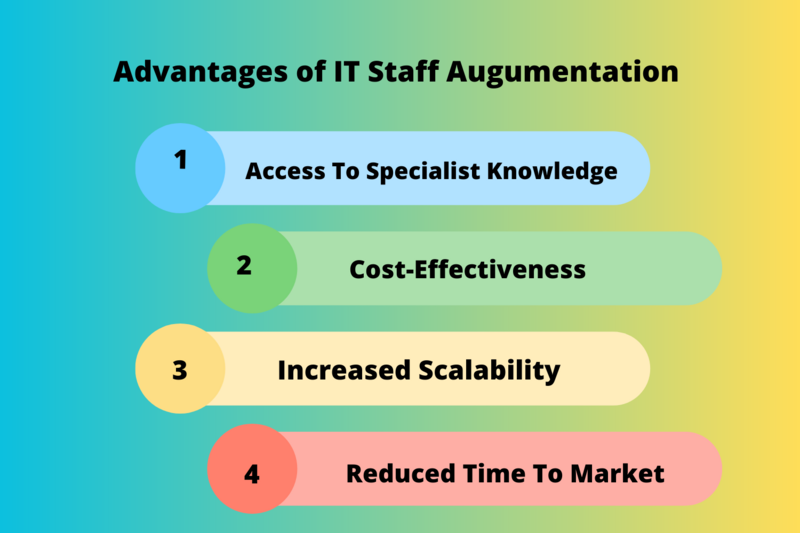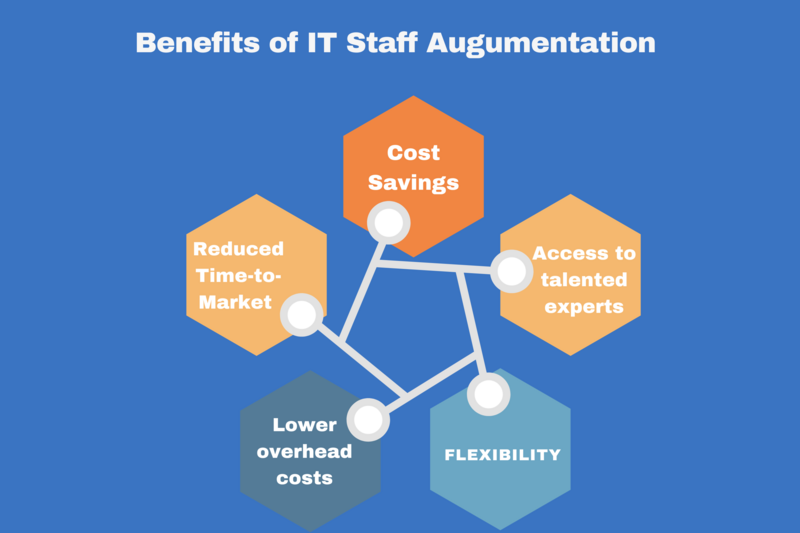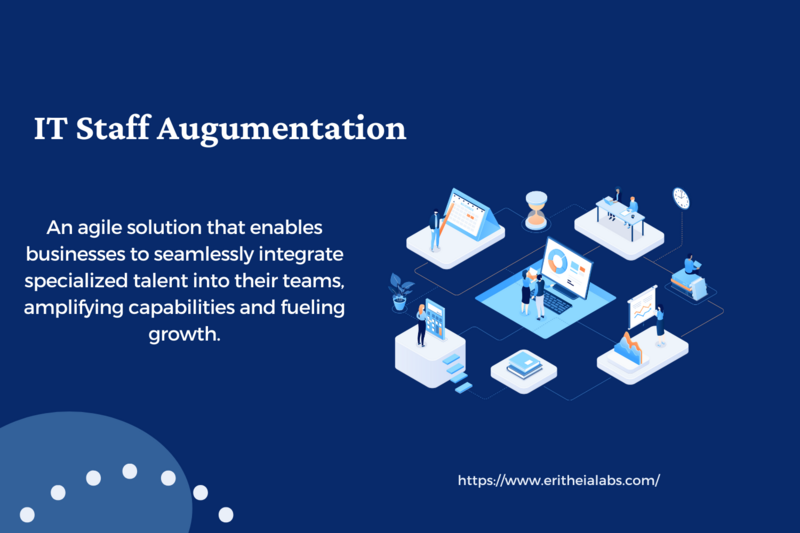Businesses face increased needs for efficient and dependable IT assistance in today's fast-paced digital landscape. IT staff augmentation and managed services have emerged as practical solutions to these problems. Businesses may access a greater spectrum of skills, improve their IT capabilities, and reach higher levels of productivity by realizing the potential of these approaches. This essay will delve into IT staff augmentation and managed services, investigating their advantages, uses, and how they may help businesses succeed.
What exactly is IT staff augmentation?
Hiring temporary personnel to enhance an organization's in-house IT workforce is called IT staff augmentation. It is contracting out a portion of a project or an IT-related task to a third-party entity, usually a staffing agency or an IT consulting firm, that supplies experienced employees to work alongside the existing team.
Companies profit from the IT staff augmentation model in various ways, including cost-effectiveness, flexibility, and Access to a larger pool of skilled IT workers. This essay will review everything you need to know about IT staffing.
What Is the Process of IT Staff Augmentation?
A corporation uses IT staff augmentation to identify the skills and resources required for a specific IT project. They then approach an IT staffing agency or consulting firm, which finds and places the appropriate employees to cover the skills gap.
The IT staffing firm is in charge of hiring, onboarding, and managing the temporary employees, while the client company watches the project and its success. The client company retains project management, and the client's team oversees the temporary workers.
Knowledge of IT Staff Augmentation:
The strategic outsourcing of competent IT experts to enhance or extend an in-house IT workforce is known as IT staff augmentation. This method allows organizations to obtain specialist personnel on demand without making long-term hiring commitments. IT staff augmentation provides flexibility and agility, whether for a short-term project, a specialized skill set requirement, or additional workers at peak hours. Organizations can swiftly scale up or down, saving time and costs in the recruitment process while maintaining project control.
Advantages of IT Staff Augmentation:
 a. Access to specialist knowledge:
a. Access to specialist knowledge:
IT staff augmentation enables firms to access a large pool of people with various skill sets. This Access to specialized knowledge can be essential when dealing with complicated IT issues, deploying cutting-edge technology, or bridging skill gaps within the existing workforce.
b. Cost-effectiveness:
IT staff augmentation may be a more cost-effective choice than hiring full-time professionals. Businesses can use outside resources as needed, saving money on recruitment, onboarding, benefits, and ongoing employment expenditures.
c. Increased scalability:
Businesses can quickly scale their IT resources up or down in response to changing project requirements or market conditions by utilizing IT staff augmentation. This adaptability ensures effective resource allocation, eliminating internal staff underutilization or overburden.
d. Reduced time to market:
Businesses can shorten project schedules and bring goods or services to market faster by employing IT workforce augmentation. The availability of competent individuals on short notice can speed up the development and deployment processes, considerably lowering time-to-market.
The Benefits of IT Staff Augmentation
 Companies gain from IT staff augmentation in a variety of ways, including:
Companies gain from IT staff augmentation in a variety of ways, including:
• Cost Savings: Hiring temporary workers for short-term tasks can be less expensive than hiring and training full-time workers.
• Access to talented experts: Businesses can Access a larger pool of qualified experts with various backgrounds and expertise.
• Flexibility: IT staff augmentation enables businesses to swiftly scale their IT teams up or down based on project needs.
• Lower overhead costs: By outsourcing temporary workers, businesses can save on office space, equipment, and other employee benefits.
• Reduced Time-to-Market: By addressing the skills gap, IT staff augmentation can speed project completion and reduce time-to-market.
The Function of Managed Services
Managed services are an all-inclusive approach to outsourcing IT operations and responsibilities. This entails collaborating with an MSP to handle various IT operations, maintenance, and support elements. MSPs are responsible for proactive system monitoring, security, problem resolution, and continuing support, allowing organizations to focus on core activities.
Advantages of Managed Services:
a. IT management that is proactive:
Managed services relieve experienced experts of the burden of day-to-day IT management and maintenance. Businesses can reduce downtime, improve system reliability, and boost overall productivity by using proactive monitoring, issue identification, and rapid resolution.
b. Concentrate on fundamental competencies:
Businesses can free up internal personnel to focus on core strengths and strategic goals by outsourcing IT administration to a specialist MSP. This allows them to focus their resources on innovation, business expansion, and client happiness.
c. Solutions that are scalable and adaptable:
Managed services provide scalable solutions that are adapted to individual business requirements. MSPs can adjust to shifting needs, giving greater support during peak periods and reducing it during quieter periods.
d. Improved cybersecurity:
Managed service companies frequently use strong security measures and stay current on the latest threats and best practices. Businesses may limit risks, preserve sensitive data, and maintain compliance with industry regulations by employing their expertise.
How to Select the Best IT Staff Augmentation Company
 Choosing the proper IT staff augmentation supplier is critical to your company's success. Consider criteria such as experience, expertise, and track record of success when selecting a service. Look for a vendor who understands your sector and can tailor solutions to your requirements. Selecting a service that provides transparent pricing and clear communication during the relationship is also critical. By choosing the proper provider, you can ensure your company receives the assistance it requires to grow.
Choosing the proper IT staff augmentation supplier is critical to your company's success. Consider criteria such as experience, expertise, and track record of success when selecting a service. Look for a vendor who understands your sector and can tailor solutions to your requirements. Selecting a service that provides transparent pricing and clear communication during the relationship is also critical. By choosing the proper provider, you can ensure your company receives the assistance it requires to grow.
When selecting an IT staff augmentation company, evaluate their experience and competence. Look for a service provider with a demonstrated track record of accomplishment in your business and recommendations from satisfied clients. Consider the provider's capacity to create customized solutions that fit your individual requirements. This could involve knowledge of specific technologies or programming languages as well as the ability to provide assistance for specific business processes. Transparent pricing and clear communication are other crucial considerations, as they can help guarantee that you obtain the required service without any surprises or hidden expenses. Finally, selecting the correct IT staff augmentation supplier will help you realize your company's full potential and generate long-term success.
Accelerating Time-to-Market with Staff Augmentation to Drive Business Growth
Companies must seize every chance to obtain a competitive advantage and shorten their time-to-market. Staff augmentation has evolved as a strategic strategy for filling talent gaps, gaining Access to specialist capabilities, and shortening project schedules. Businesses can promote business success by employing staff augmentation, tapping into a large talent pool, rapidly increasing their teams, and accelerating time-to-market. In this article, we will look at how staff augmentation may help businesses develop by allowing them to bring products and services to market faster than ever before.
- Access to a Diversified Pool of Talented Professionals:
Staff augmentation gives firms a diversified pool of talented professionals. Staff augmentation enables businesses to access specialized skills without needing protracted recruitment processes, whether for software developers, data analysts, designers, or project managers. Businesses may quickly augment their teams with professionals with the precise capabilities required for their projects by working with a respected staff augmentation service, ensuring the right talent is accessible at the right time.
2. Rapid Scalability and Flexibility:
One of the critical benefits of staff augmentation is the capacity to scale up or down in response to project demands quickly. Staff augmentation allows businesses to scale up their teams quickly when experiencing rapid expansion, launching new initiatives, or dealing with time-sensitive tasks. This scalability guarantees that companies have the resources to meet project deadlines, capitalize on market opportunities, and develop their businesses. Furthermore, staff augmentation provides firms with flexibility by allowing them to modify the size of their teams as projects evolve or wind down, maximizing resource allocation and cost-effectiveness.
3. Faster Onboarding and Time-to-Productivity:
Staff augmentation shortens onboarding, allowing firms to expedite project time-to-productivity. Staff augmentation, as opposed to traditional employment, which frequently entails time-consuming recruitment, interviews, and training, allows quick Access to experienced people who are already familiar with the essential technologies and processes. This rapid integration into the project will enable businesses to get up and running quickly, saving significant time and ensuring speedier project execution.
4. Leveraging Specialized Skills and Expertise:
Specialized skills and expertise are frequently required for innovation and differentiation. Staff augmentation enables companies to access unique skill sets that may not be readily available within their teams. Staff augmentation gives Access to people with the specific knowledge required for these jobs, whether they are integrating emerging technologies, constructing sophisticated software systems, or conducting in-depth data analysis. Utilizing specialist abilities can result in higher-quality deliverables and more productivity and promote corporate growth by more efficiently satisfying customer requests.
5. Reduced costs and higher ROI:
Staff augmentation is a low-cost workforce management method. Businesses can avoid the costs of full-time hires by employing external talents, such as recruitment charges, employee benefits, and ongoing overhead. Staff augmentation companies provide administrative functions such as payroll and benefits, freeing firms from these costs. Furthermore, by reducing time-to-market, staff augmentation enables businesses to generate revenue more quickly, increasing return on investment (ROI) and contributing to total corporate growth.
Implementations of successful IT staff augmentation
Many companies have effectively used IT staff augmentation to increase productivity and efficiency. A healthcare company, for example, might utilize IT staff augmentation to build a new electronic medical records system. In contrast, a financial services organization might use it to create a new trading platform. Businesses may swiftly and efficiently implement new technologies and processes by leveraging the experience of IT professionals, eliminating the need for costly and time-consuming internal hiring processes. Companies can reach their objectives by utilizing the correct IT staff augmentation service.
A retail company that hired IT specialists to construct a new e-commerce platform is one example of a successful IT staff augmentation project. The organization established a flawless online shopping experience for their clients by bringing in professionals in web development and user experience design. A manufacturing company, for example, used IT staff augmentation to develop a new inventory management system. The organization was able to optimize its inventory operations and decrease waste by leveraging the experience of IT specialists, resulting in significant cost savings. These are a few instances of how businesses might benefit from IT staff augmentation to help them reach their objectives more effectively.
Newsletter to recieve
our latest company updates
Comment